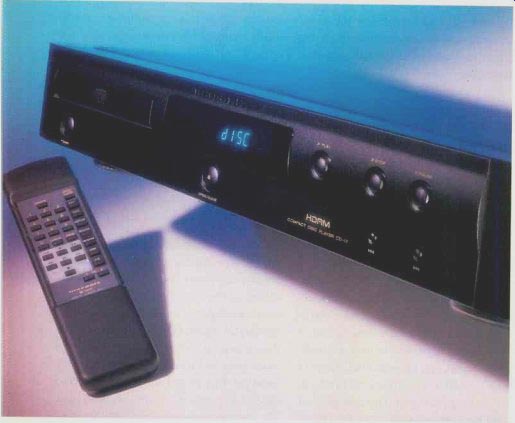
by DANIEL KUMIN
Dimensions: 18 1/2 in. W x 3 3/8 in. H 12 1.5 in. D (46.5cmx8.4cmx30.5cm)
Weight: 17 lbs. (7.7 kg).
Price: $1,199.
Company Address: 440 Medinah Rd. Roselle, Ill. 60172; 630/307-3100.
In its 15 years of existence, the Compact Disc format has seen dozens of variations in player layout and function.
These have run the gamut from the ridiculous (the three-disc "robot-arm" changer in a shelf system of a few years ago springs to mind) to the extreme (such as three-piece players-with power sup ply, transport, and D/A converter in separate chassis-costing as much as a family sedan). Yet the one-box, single-disc player remains one of the most popular options. This may reflect no more than con sumer habit and expectation, but it could also have something to do with an inherent perfection of design.

Marantz's CD-17 is an apt case study. It is simple and elegant, and its operation is self-evident. This is the latest CD design from one of the oldest names in audio, a firm that is a subsidiary of the format's co developer, Philips. Marantz characterizes the new player, which occupies the next-to-top slot in the company's lineup, as an effort to "design a CD player without compromises... [that is still] within reach of the vast majority of music lovers." In keeping with Marantz's high-end goals for this player, the CD-17 is exceptionally restrained on the outside. The low profile black fascia presents just seven but tons, a centralized display, and the disc drawer. The buttons control power, open/ close, play, pause, stop, and backward and forward track-skip. All other functions are accessible only via the supplied remote control. On the rear panel are gold-plated RCA jacks for stereo analog output, a single coaxial S/PDIF digital port, and a nickel-plated jack pair for Marantz's inter-component, unified-remote system. (Presumably, at this level of audio sophistication we need not fear that the new owner might plug these jacks into a power amplifier, which would doubtless yield a nasty surprise.) Under the hood, the CD-17 reveals construction quality several cuts above that of "mass-market" brands. The player is assembled on a heavier-gauge steel pan than I see on most under-$1,000 designs, with all-metal bolt-on side, front, and back assemblies. A beefy power transformer accounts for a good portion of the CD-17's very substantial weight. However, another few pounds are added by two-layer, metal sub panels bolted to each side, underneath the extruded-aluminum exterior panels; these could probably be argued as "anti-resonance" components, but that won't stop my wondering if they are there as much simply to add heft.
Whatever the reason, construction and component quality appear well above aver age throughout. The CD-17's sheet-metal craft is outstanding, and its internal goings on appear no less carefully managed. The single main circuit board is only about 8 inches square (like many CD players, the CD-17 could easily fit a smaller chassis).
The only visible jumpers are the ribbon connectors to the disc drive and display and a heavy wiring harness to the rather substantial power-supply section. That supply, which resides behind the drive mechanism, appears quite thoroughly filtered and regulated.
The CD-17 employs Philips's top-shelf CD-7 and DAC-7 digital-to-analog conversion components as well as 20-bit digital filtering and an all-discrete analog output stage. The transport is the Philips CDM-12 mechanism, a compact plastic and metal assembly, extensively sprung, that incorporates a three-beam laser, pickup-sensor op tics, and integral servo and demodulator/decoder electronics. Mechanical clamping is part of the assembly; the linear-tracking sled rises to meet the disc, though this doesn't add significant mass to the rotating disc.
Philips hardware manages the digital interface and conversion steps, with the exception of an NPC third-order noise-shaping digital filter IC. D/A conversion is via Philips's TDA1547, the Dutch firm's latest Bitstream "1-bit" device; in this case the chip carries dual converters in a complementary topology to further reduce conversion errors.
Following the digital hardware, the de sign is said to be all-discrete, via hyper-dynamic amplifier module (HDAM) analog stages. These are two modestly potted modules, about a half-inch high, covered by classy copper casings embossed with the Marantz logo. What's in there is anybody's guess; Marantz says the contents are discrete J-FET line-amp circuits. Each channel appears to be locally, independently regulated and supply-filtered and to be followed by a discrete-transistor output pair just ahead of the output jacks.
-----------------

The CD-17's front panel is very clean; most functions are
controlled from the 30-key remote.
Measurements
The Marantz CD-17 was a pleasure to test. That's far from universal for CD players, where odd behavior and head-scratching results are relatively common, especially at the very low distortion and noise levels of to day's digital audio. To verify Marantz's specifications, I used a 20-kHz "brick-wall" filter in the measurement loop. Philips recommends this for all its Bitstream de vices, to limit the influence of ultrasonic noise-which, as a consequence of the Bitstream system's noise shaping, is relatively high. I confirmed this and used the very steep brick-wall filter option of the Audio Precision System One analyzer for all tests in which distortion-plus-noise was a factor.
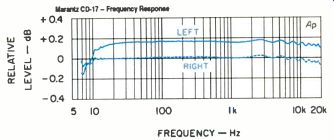
Fig. 1-Frequency response.
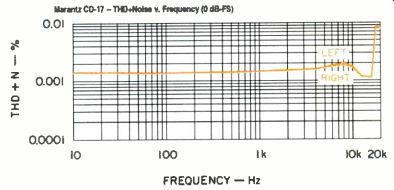
Fig. 2-THD + N vs. frequency at 0 dBFS.
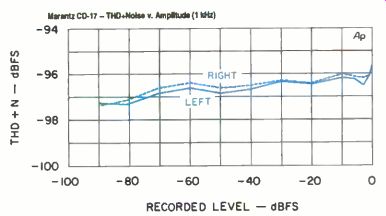
Fig. 3-THD + N vs. level at 1 kHz.
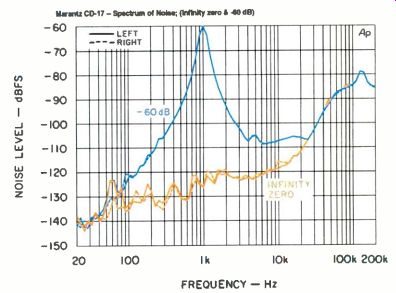
Fig. 4--Spectrum analyses for an "infinity-zero" signal and a 1-kHz
tone at-60 dBFS.
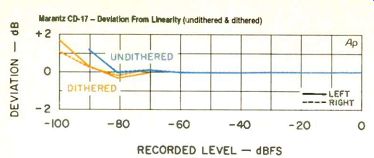
Fig. 5--Deviation from linearity at 1 kHz.
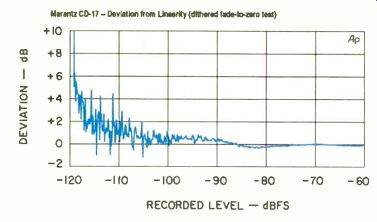
Fig. 6--Fade-to-noise test, dithered 500-Hz tone.
The results so derived were impressive: Technically, digital audio is getting exceptionally good all around, and the CD-17 is a superb demonstration.
Frequency response, seen in Fig. 1 (note the expanded vertical scale), is very flat overall; the general deviation is less than 0.1 dB.
However, there's a channel imbalance of about 0.16 dB. The filter response ripple visible in the top two octaves is only about 0.1 dB, peak to peak, and can be considered in consequential.
The CD-17's total harmonic distortion plus noise (THD + N) at 0 dBFS (Fig. 2) closely matches Marantz's spec (0.0015% at 1 kHz) and remains extremely low over the entire band, not even reaching 0.01%. The generally rising trend suggests the influence of residual noise; removing the brick-wall filter and retesting THD + N caused the curves (not shown) to jump an order of magnitude, peaking at about 0.1% at 18 kHz. Using the remote's volume control to dial in a 20-dB cut induced about the same degradation of THD + N, which indicates that this should be done only for convenience-no surprise there.
Figure 3 shows THD + N versus recorded level at 1 kHz; the curves' relative flatness up to 0 dBFS speaks well of the analog out put stage's linearity and dynamic range.
Figure 4 offers superimposed spectral plots of residual noise and distortion, for an "infinity-zero" silent track and for a -60 dB tone. The most notable feature is the-79 dB noise hump at about 130 kHz, which appears related to noise shaping (3 x fs equals 132.3 kHz). The overall noise suppression in the audio band is very good, and the ultimate low-frequency suppression is more than very good. The absence of any power-line harmonics higher than-124 dB (at 60 Hz) puts hum altogether out of the picture.
The only thing the -60 dB curve reveals that might at a stretch be called a distortion product is at 5 kHz (the fifth harmonic; the second through fourth harmonics are, of course, buried in the filter's skirts).
Signal-to-noise ratio was about 108 dB, A-weighted, in each channel-very good indeed. Dynamic range (using the A-weighted system of measuring residual noise for a-60 dB tone and adding 60 dB to the result) was nearly 100 dB-outstanding.
Philips's Bitstream high-speed, noise-shaping DACs have supplied accurate, cost effective D/A conversion for many years now, and those in the CD-17 are the latest example. Figure 5 shows deviation from linearity for undithered 1-kHz tones from 0 to -90 dBFS and dithered tones from-70 to -100 dBFS. Any player that delivers better than 2-dB accuracy down to-100 dBFS gets my attention, and the Marantz kept it with Fig. 6, the fade-to-noise test with a dithered, 500-Hz tone. In this in stance, accuracy is arguably within 1 dB to nearly -110 dBFS--superb.
The results for only one channel are presented here; the two channels' curves were extremely well matched at all points, which is far from common.
In the thump-on-the-case test, the CD-17 rated a horizontal-knock A+ and a vertical-mode A-.
Either way, I had to slug the player pretty solidly or drop one side from an inch or so to induce a skip. (This does not necessarily have anything to do with susceptibility to audio-frequency vibrations, but it's a test every shopper should perform.) On the Pierre Vernay test disc (PV.788031/32), which contains deliberate defects, the Marantz tracked 1.5-millimeter dropouts flawlessly and successfully negotiated 2-millimeter blanks without skipping but with an occasional sharp "snap"--wow!
Use and Listening Tests
Operating the Marantz CD-17 proved mostly intuitive. Since the front panel offers just basic controls, day to-day operation will typically be from the remote, which, unfortunately, is a bit uninspired ergonomically. Its 30 identical keys are all black, all small, and all closely spaced. The keys are intelligently laid out, with the main transport controls offset by a different background.
To the CD-17's front-panel controls, the remote adds audible fast search (two-speed, of the hold-down variety); disc-, track-, and A-B repeat modes; automatic music search (does anyone out there ever use this?); and 30-track random-access programming. You can also perform delete programming to skip one or two hated tracks on an otherwise well-liked disc, a sort of programming that some music lovers might actually find occasionally useful. The remote delivers easy-chair volume control, too, which will be a convenience to those whose preamps, amplifiers, or receivers lack remote control. Though I did not hear any clear effects of using it (at-20 dB or so), my lab tests did show that itcom - promises dynamic range and increases distortion a bit, so it is best reserved as an occasional convenience.
The remote also has keys to select elapsed or remaining track time, remaining disc time, and random play. The CD-17's "Edit" function is a rather simple and potentially very handy tape-recording aid; it quickly divides a disc's tracks into two groups for recording onto 90-, 60-, or 46-minute tapes-or any other duration you key in.
With a Marantz (or compatible) tape deck and the intercomponent remote-communication hookup, the CD-17 will perform synchro recording. It does not, however, offer Philips's handy Favorite Track Selection (FTS) memory to retain your programmed sequences disc by disc from session to session.
I lived with the CD-17 as my main player for nearly two months, doing extensive listening on my "big" system (B&W 803 Matrix Series 2 speakers, Parasound HCA 2003 amp, and Citation 7.0 preamp) and on the system in my home studio (modified Dyna Stereo 70 power amp and NHT SuperOne two-ways in near-field position). I formed a couple of consistent opinions about the Marantz, which impressed me as a very effective player that should be able to keep up in virtually any system.
-------------
MEASURED DATA
Line Output Level, 0 dBFS: 2.37 volts (left channel).
Channel Balance: Right channel 0.16 dB below left.
Line Output Impedance: 195 ohms.
Frequency Response: +0.17,-0.07 dB, 20 Hz to 20 kHz.
Channel Separation: Greater than 102 dB, 125 Hz to 16 kHz.
THD + N at 0 dBFS: Less than 0.009% from 20 Hz to 20 kHz, 0.0014% at 1 kHz.
Maximum Linearity Error: Undithered recording, +1.22 dB at-90 dBFS; dithered recording, +1.75 dB at-100 dBFS.
A-Weighted S/N: 107.9 dB.
Quantization Noise:-96.4 dBFS.
Dynamic Range: Unweighted, 97 dB; A-weighted, 98.9 dB.
-------------
The CD-17 maintains a very quiet, deep, "black" background for music to develop from. On Lyle Lovett's "North Dakota" (Joshua Judges Ruth, MCA MCAD-10475), the sparse opening bars of hand percussion sounded transparent and only naturally crisp, with the decaying tail of the recording's top-quality studio reverb delivered full-length and smoothly intact. The Marantz also preserved spatial characteristics extremely well: The first moments of Janis Ian's Breaking Silence ( Morgan Creek 2959-20023) distributes voice, hand percussion, and guitars over a fairly broad stage; the CD-17 delivered full-breadth sound with excellent stability and a very believable illusion of space and depth.
Music with wide dynamic range brought out the best in the player. A Denon recording of Mahler's Ninth Symphony (Eliahu Inbal and the Frankfurt Radio Symphony, Denon CO-1566/67) is an oldie-but-goodie that I've found a good test. This decade-old recording doesn't match the best of today's discs sonically, but it still sounds excellent on an accurate player; on less-exact hard ware it can come across a bit harsh or artificial. The massive opus sounded fine via the CD-17, notably the Rondo's extensive triple forte and dense counterpoint, which maintained good definition, timbre, and natural smoothness. I also observed excellent bottom-octave sound and impact from the Marantz player during all my listening.
Deep-bass character sometimes seemed a touch richer than from my everyday player.
The Marantz CD-17 is a very fine and highly musical basic Compact Disc player.
Obviously, you could buy a better one, at least on paper, for two or three times the money. But I also believe that it's equally possible (and statistically more probable) that you could spend the larger sum and end up with no audible gain. Which puts the CD-17 right where it ought to be. A
(Source: Audio magazine, Feb. 1997 )
Marantz CD3577 Compact Disc Player (Equip. Profile, Dec. 1990)
Marantz CD-94 CD Player and CDA-94 D/A Converter (Equip. Profile, Aug. 1988)
Marantz CDR-1 Professional CD Recorder (Apr. 1992)
Philips CD960 Compact Disc Player (Jun. 1988)
Philips CD880 Compact Disc Player (Jan. 1989)
Philips LHH 500 CD Player (Apr. 1992)
Philips LHH1000 compact disc playback system (Jan. 1990)
Mod Squad Prism Compact Disc Player (Aug. 1988)
Magnavox CDB650 CD player (Mar. 1987)
= = = =